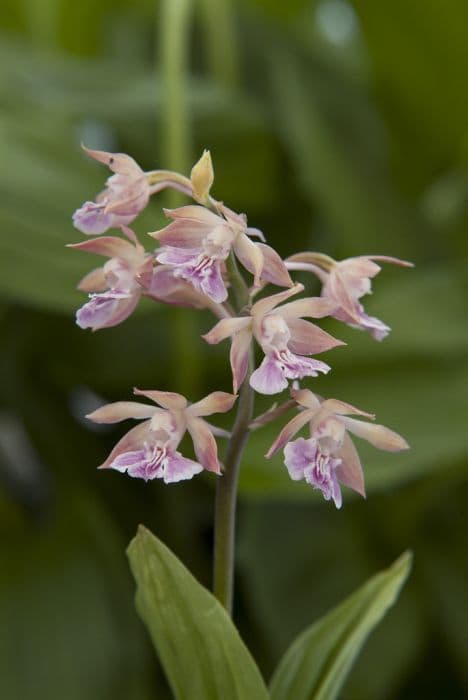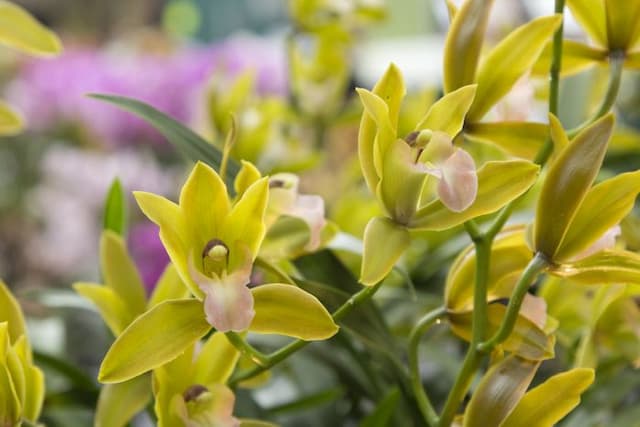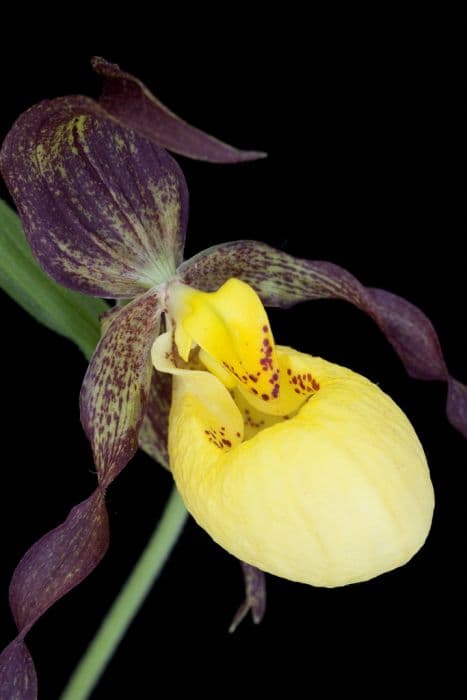Dancing Lady Orchid Oncidium Jungle Monarch gx

ABOUT
The Oncidium Jungle Monarch gx, also commonly known as the Dancing Lady orchid, is a hybrid with a striking and usually plentiful display of flowers. The flowers of the Dancing Lady orchid are notable for their distinctive shape, often resembling the skirts of a dancing girl, which is where the common name is derived from. The blooms are typically arranged in a branched pattern on flower spikes that emerge from the base of the plant. The flowers themselves exhibit a variety of colors, generally featuring a bright yellow background with brown or reddish markings that serve as beautiful contrasts, enhancing the visual appeal of the plant. The petals and sepals are elongated and may have wavy or ruffled edges, giving them a delicate, frilly appearance. In the center of the flower, there is often a contrasting lip, which might be of a different color, adding further to the exotic look of the orchid. The leaves of the Dancing Lady orchid are slender, elongated, and leathery in texture, adding a rich green backdrop to the lively colors of the flowers. This plant can boast a robust and healthy foliage that enhances the overall lushness of the orchid display. The Dancing Lady orchid is a popular choice among orchid enthusiasts for its showy flowers and the relatively easy care compared to some other orchid varieties.
About this plant
 Names
NamesSynonyms
Dancing Lady Orchid, Golden Shower Orchid.
Common names
Oncidium Jungle Monarch gx.
 Toxicity
ToxicityTo humans
The Oncidium, commonly referred to as the Dancing Lady orchid, is generally not considered toxic to humans. If ingested, it is unlikely to cause any significant symptoms of poisoning. However, as with any non-food plant, individual sensitivities can vary, and consumption of plant parts may cause mild stomach upset in some individuals.
To pets
The Oncidium, or Dancing Lady orchid, is also not known to be toxic to pets. It is generally safe if pets come into contact with it or accidentally ingest small quantities. However, gastrointestinal upset may occur if a pet ingests a significant amount of the plant, due to the plant material being indigestible rather than any specific toxic principle.
 Characteristics
CharacteristicsLife cycle
Perennials
Foliage type
Evergreen
Color of leaves
Green
Flower color
Mixed
Height
1 foot 2-3 feet [0.3-0.9 meters]
Spread
1 foot 2-3 feet [0.3-0.9 meters]
Plant type
Orchid
Hardiness zones
1
Native area
South America
Benefits
 General Benefits
General Benefits- Enhances Aesthetics: The Oncidium Jungle Monarch, commonly known as the Dancing Lady Orchid, adds elegance and tropical flair to any indoor space with its vibrant, butterfly-shaped blooms.
- Improves Mood: The bright and lively appearance of the Dancing Lady Orchid can help to elevate mood and provide a sense of well-being.
- Encourages Responsibility: Caring for an orchid like the Dancing Lady requires a certain level of attention and dedication, fostering responsibility in caregivers.
- Provides Educational Opportunities: Growing this orchid offers a chance to learn about botanical care and the unique symbiotic relationships within ecosystem.
- Promotes Patience: Orchids, including the Dancing Lady, typically require time and patience to bloom, rewarding caregivers with their striking flowers after a period of careful nurturing.
- Increases Humidity: Like many orchids, the Dancing Lady Orchid can add moisture to the air through transpiration, which can be beneficial in dry indoor environments.
- Boosts Creative Inspiration: The exotic and intricate flowers of the Dancing Lady Orchid can serve as a source of creative inspiration for artists, writers, and anyone in need of a muse.
- Offers Long-lasting Blooms: The flowers of the Dancing Lady Orchid can last for several weeks, providing long-term enjoyment from a single blooming period.
- Creates Learning Projects: Those with children or students can use the care and growth of the Dancing Lady Orchid as a project to teach about plant growth cycles and horticulture.
- Social Interaction: Sharing experiences and tips about growing Dancing Lady Orchids can create opportunities for socializing with other orchid enthusiasts.
 Medical Properties
Medical PropertiesThis plant is not used for medical purposes.
 Air-purifying Qualities
Air-purifying QualitiesThis plant is not specifically known for air purifying qualities.
 Other Uses
Other Uses- Photography Subject: The Oncidium Jungle Monarch's striking blooms make it a popular choice for photographers and plant enthusiasts who want to capture its beauty in still-life photography.
- Decorative Art: Artists and crafters can use the dried flowers to create decorative pieces, such as pressed flower art or inclusion in resin jewelry.
- Insectarium Displays: The plant can be a part of insectarium and butterfly garden exhibits as it can attract certain species of butterflies and bees for pollination.
- Educational Tool: Botany educators may use the Oncidium Jungle Monarch to teach students about orchid care, plant reproduction, and hybridization processes.
- Wedding Decor: The vibrant flowers can be used in wedding bouquets, centerpieces, and venue decorations for a tropical or exotic theme.
- Fashion Inspiration: The unique patterns and colors of the flowers can inspire textile designs and patterns for fashion designers looking for natural motifs.
- Perfumery: Though not a common use, the subtle fragrance of the Oncidium Jungle Monarch can inspire natural perfume blends for artisanal perfumers.
- Culinary Presentation: Some high-end restaurants use the edible varieties of Oncidium flowers to embellish and garnish plates for an exotic touch.
- Horticultural Shows: The impressive and diverse Oncidium Jungle Monarch orchids are often highlights in orchid shows and horticultural competitions.
- Green Roofing: In suitable climates, this orchid could potentially be used in green roofing projects where its aesthetics contribute to the urban environment.
Interesting Facts
 Feng Shui
Feng ShuiThe Oncidium or Dancing Lady Orchid is not specifically mentioned in traditional Feng Shui practice, but as with other houseplants, it can be used to add life energy or 'chi' to a home. It's generally advised to place such plants in areas where you want to introduce growth and vitality, such as the east (for health) or southeast (for wealth and abundance) sectors of your space.
 Zodiac Sign Compitability
Zodiac Sign CompitabilityThe Dancing Lady Orchid is not used in astrology practice.
 Plant Symbolism
Plant Symbolism- Vitality: Oncidiums, also known as "Dancing Lady Orchids," often symbolize vibrant energy due to their bright colors and lively patterns that resemble a dancer.
- Beauty: Orchids in general are commonly associated with beauty and perfection, reflecting their diverse and stunning appearances.
- Strength: Despite their delicate looks, orchids are resilient plants that can thrive in various challenging environments, representing inner strength and adaptability.
- Nobility: Historically, orchids were rare and considered luxurious, thus symbolizing nobility and refinement.
- Love: Given as gifts, they express love and affection, often attributed to their exotic and alluring nature.
- Fertility: Some cultures associate orchids with fertility and abundance due to their prolific seed production.
 Water
WaterThe Dancing Lady Orchid, commonly known as the Oncidium Jungle Monarch gx, prefers to be watered when the top inch of the potting mix feels dry. Generally, this equates to watering approximately once every seven to ten days, depending on environmental conditions. When you water, do so thoroughly, allowing water to run freely out of the pot's drainage holes, but be sure to empty any collected water from the saucer to prevent root rot. An average guideline for mature plants is to use about one pint of water per week, adjusting for plant size and environmental factors like humidity and temperature.
 Light
LightThe Dancing Lady Orchid thrives in bright, indirect sunlight. Ideally, place it near an east or west-facing window where it can receive a few hours of gentle morning or late afternoon sun. However, direct midday sun should be avoided, as it can scorch the delicate leaves of the plant. Sheer curtains can be used to diffuse intense sunlight and provide the perfect lighting conditions.
 Temperature
TemperatureThe ideal temperature range for the Dancing Lady Orchid is between 60 and 80 degrees Fahrenheit. These orchids can typically tolerate a minimum nighttime temperature of about 50 degrees Fahrenheit and a maximum daytime temperature up to 85 degrees Fahrenheit. However, to encourage blooming, a slight drop in nighttime temperature, around 55 to 65 degrees Fahrenheit, is beneficial.
 Pruning
PruningPrune the Dancing Lady Orchid to remove dead or yellowing leaves and spent flower spikes, which encourages new growth and ensures the plant's energy is directed towards healthy tissues. The best time to prune is after the orchid has finished blooming. Pruning can be done annually, or as often as necessary to maintain the plant's shape and health.
 Cleaning
CleaningAs needed
 Soil
SoilOncidium Jungle Monarch, commonly known as Dancing Lady Orchid, requires a well-draining soil mix, often composed of fir bark, charcoal, and perlite. The ideal soil pH level for this orchid is slightly acidic to neutral, ranging between 5.5 and 7.0. Regular orchid potting mixes available at garden centers are typically suitable for these plants.
 Repotting
RepottingDancing Lady Orchids should be repotted once every two to three years or when the potting medium starts to decompose. This species benefits from fresh media to support its growth and prevent root rot, which can occur in old, broken-down medium.
 Humidity & Misting
Humidity & MistingDancing Lady Orchids thrive in environments with high humidity levels, ideally between 40% and 70%. They perform best when the air around them is moist, but circulation of air is also important to prevent issues like mold and rot.
 Suitable locations
Suitable locationsIndoor
Place in bright, indirect light with high humidity for indoor growth.
Outdoor
Grow in dappled sunlight, sheltered from strong winds and heavy rain.
Hardiness zone
9-11 USDA
 Life cycle
Life cycleThe Oncidium Jungle Monarch, commonly known as the Dancing Lady Orchid, begins its life cycle when a seed germinates, usually in the crevices of tree bark or in other organic material where it can form a symbiotic relationship with a mycorrhizal fungus. The seedling develops into a protocorm, a small, bulb-like structure, which then forms roots and shoots as it matures into a young orchid plant. As the plant grows, it forms pseudobulbs, which are storage organs that help the plant survive in periods of drought. The orchid then reaches maturity and produces inflorescences, which carry numerous small, butterfly-shaped flowers renowned for their intricate patterns and dancing appearance. After pollination, which is often facilitated by insects attracted to the flowers’ colors and scents, the plant will produce seed capsules containing thousands of minute seeds. Once dispersed, these seeds can give rise to new orchid plants, thereby continuing the cycle.
 Propogation
PropogationPropogation time
Spring-Early Summer
The Oncidium Jungle Monarch gx, commonly referred to as a type of Dancing Lady Orchid, can be propagated most effectively through division, particularly during the spring when the plant is beginning to enter a more active growth phase. The process involves gently separating the pseudobulbs that have at least one leaf, making sure each division has an adequate amount of roots. Using a sterile blade, the grower should carefully cut through the rhizome connecting the pseudobulbs. It is essential to pot each division into its own container with appropriate orchid potting mix, ensuring that the pot size corresponds to the size of the division, usually about an inch or two larger in diameter (2.54 to 5.08 centimeters). After division, it's crucial to maintain a high humidity level and adequate but indirect lighting to support the development of the new plants.









